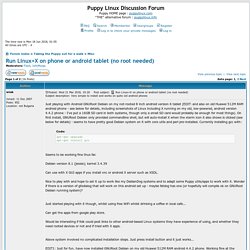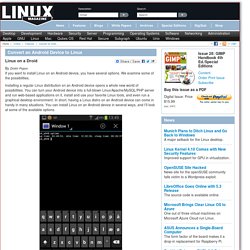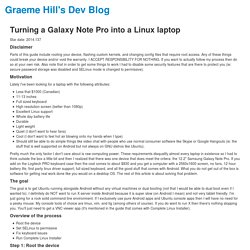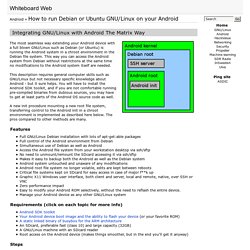

Maru project is supporting lineage OS. Sorry to don570 for having been such a grouch yesterday.

Now from an objective point of view, to keep working in my trade, I need a full keyboard. Not a virtual keyboard, not half a keyboard, a full keyboard. And I'm sure I am not the only professional with a need for a traditional computer with a full keyboard. A secondary aspect is that, twenty years ago, when people muttered to themselves on the street, you called the cops or the paramedics, and they locked up those people in looney bins (aka asylums, aka mental hospitals). Now people are talking to themselves on the street all the time, and no one is doing anything about it!!! As to this MARU -- and I quote from the page provided by jrb: "Your phone is your PC. " -- Nope. Now for some dissection, if I may: "Maru packs a complete desktop experience on your smartphone. " Second sentence: "Your phone runs independently of your desktop so you can take a call and work on your big screen at the same time.
" Oh? MARU is not needed. Run Linux+X on phone or android tablet (no root needed) Just playing with Android GNURoot Debian on my not-rooted 8 inch android version 6 tablet (EDIT: and also on old Huawei 512M RAM android phone - see below for details, including screenshots of Linux including X running on my old, low-powered, android version 4.4.2 phone - I've put a 16GB SD card in both systems, though only a small SD card would probably be enough for most things).

On first install, GNURoot Debian only provided commandline shell, but will auto-install X when the xterm icon it also shows is clicked (see below for details) - seems to have pretty good Debian system on it with core utils and perl pre-installed. Currently installing gcc with: Seems to be working fine thus far. Debian version 8.1 (jessie); kernel 3.4.39 Can use with X GUI apps if you install vnc or android X server such as XSDL. Nice to play with and hope to set it up to work like my DebianDog systems and to adapt some Puppy utils/apps to work with it. Can get the apps from google play store. EDIT2: Wow! Convert an Android Device to Linux. Installing a regular Linux distribution on an Android device opens a whole new world of possibilities.

You can turn your Android device into a full-blown Linux/Apache/MySQL/PHP server and run web-based applications on it, install and use your favorite Linux tools, and even run a graphical desktop environment. In short, having a Linux distro on an Android device can come in handy in many situations. You can install Linux on an Android device in several ways, and I’ll look at some of the available options. Figure 1: KBOX is a miniature Linux distribution that doesn’t require rooting.
Complete Linux Installer (Android) Linux Deploy. No Root (Linux on Android) KBOX (Linux on Android) GNURoot (Linux on Android w/o Root) Debian noroot. Turning a Galaxy Note Pro into a Linux laptop. Disclaimer Parts of this guide include rooting your device, flashing custom kernels, and changing config files that require root access.

Any of these things could break your device and/or void the warranty. I ACCEPT RESPONSIBILITY FOR NOTHING. If you want to actually follow my process then do so at your own risk. Also note that in order to get some things to work I had to disable some security features that are there to protect you (ie: secure password storage was disabled and SELinux mode is changed to permissive). Motivation Lately I've been looking for a laptop with the following attributes: Pretty much the only factor I don't care about is raw computing power. The goal The goal is to get Ubuntu running alongside Android without any virtual machines or dual booting (not that I would be able to dual boot even if I wanted to). Overview of the process Root the deviceSet SELinux to permissiveFix keyboard issuesRun Complete Linux Installer Step 1: Root the device Step 3: Fix keyboard issues.
Varun's ScratchPad: [How to] Install Linux on Android? How to run Debian or Ubuntu GNU/Linux on your Android. Integrating GNU/Linux with Android The Matrix Way The most seamless way extending your Android device with a full blown GNU/Linux such as Debian (or Ubuntu) is running the Android system in a chroot environment in the Debian file system.

This way you can access the Android system from Debian without restrictions at the same time no modifications to the Android system itself are needed. This description requires general computer skills such as GNU/Linux but not necessary specific knowledge about Android - but it sure helps. You will have to install the Android SDK toolkit, and if you are not comfortable running pre-compiled binaries from dubious sources, you may have to get at least parts of the Android OS source code as well. A new init procedure mounting a new root file system, transferring control to the Android init in a chroot environment is implemented as described here below. Features Requirements (click on each topic for more info) Steps Partition the SDcard.
Distribution Specific Tools (Linux on Android) Kali Linux on Anroid. Android on Linux. Ubuntu Android. ROMs & Rooting (Android) Mobile Linux Distributions.